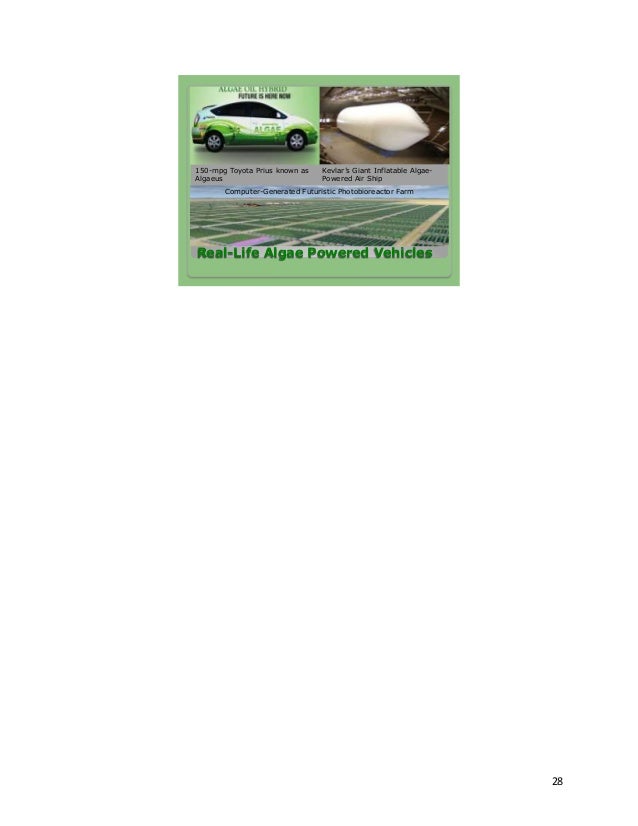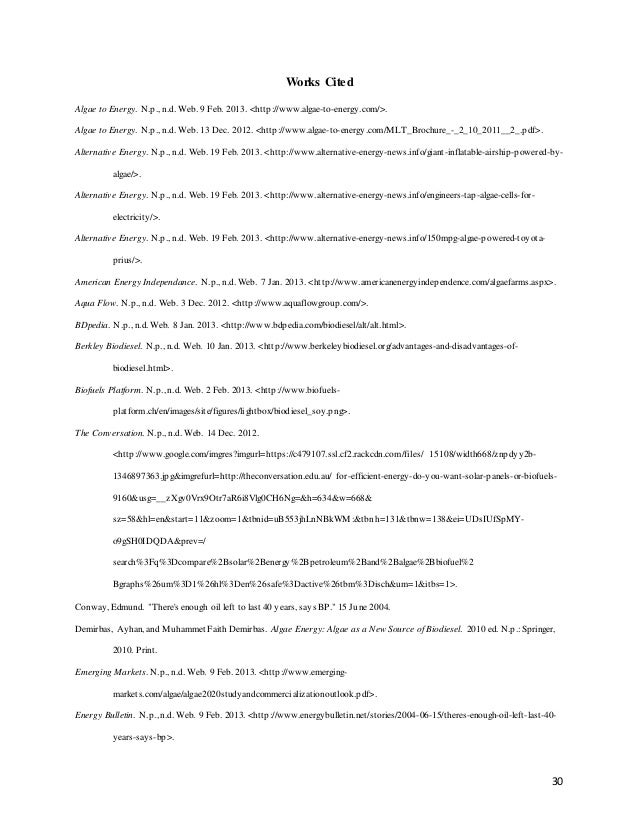
algae. While the general idea of using algae for energy pro-duction has been around for over 50 years (Meier, ), the concept of using lipids derived from algal cells to produce liquid fuels arose more recently.[13] Historically, algae have been seen as a promising source of protein and have been ac- 5 rows · Nov 01, · This paper describes the potential for algal biomass production in conjunction with wastewater Cited by: Nov 01, · Words 5 Pages. ALGAE. ALGAE Algae are eukaryotic organisms that have no roots, stems, or leaves but do have chlorophyll and other pigments for carrying outphotosynthesis. Algae can be multicellular or unicellular. Unicellular algae occur most frequently in water, especially in plankton
Harvesting wild algae to make paper | Society for Science
To browse Academia. edu and the wider internet faster and more securely, please take a few seconds to upgrade your browser. Skip to main content. edu no longer supports Internet Explorer. Log In Sign Up. Microalgae 9, algae research paper, Followers. Papers People. Simultaneous hydrolysis-esterification of wet microalgal lipid using acid.
This research demonstrated hydrolysis of wet microalgal lipid and esterification of free fatty acid FFA using acid in one-step process. The investigation of simultaneous hydrolysis-esterification SHE of wet microalgal lipid was The investigation of simultaneous hydrolysis-esterification SHE of wet microalgal lipid algae research paper conducted by using L27 orthogonal design and the effects of water content, volume of sulphuric acid, volume of methanol, algae research paper, temperature and time on SHE were examined, algae research paper.
As a result, water content was found to be the most effective factor. Equimolar amounts of sulphuric acid and hydrochloric acid showed similar results, algae research paper. This method has great potential in terms of biodiesel production from microalgae since no organic solvents are used.
Save to Library. Anaerobic co-digestion of coffee husks and microalgal biomass after thermal hydrolysis. Residual coffee husks after seed processing may be better profited if bioconverted into energy through anaerobic digestion. This process may be improved by implementing a pretreatment step and by co-digesting the coffee husks with a more This process may be improved by implementing a pretreatment step and by co-digesting the coffee husks with a more liquid biomass.
In this context, this study aimed at evaluating the anaerobic co-digestion of coffee husks with microalgal biomass. Furthermore, thermal hydrolysis pretreatment increased coffee husks anaerobic biodegradability. Anaerobic digestion of microalgal biomass after ultrasound pretreatment. High rate algal ponds are an economic and sustainable alternative for wastewater treatment, where microalgae and bacteria grow in symbiosis removing organic matter and nutrients, algae research paper.
Microalgal biomass produced in these systems can be Microalgal biomass produced in these systems algae research paper be valorised through anaerobic digestion. However, microalgae anaerobic biodegradability is limited by the complex cell wall structure and therefore a pretreatment step may be required to improve the methane yield. Mathematical modelling revealed that ultrasonication had a higher effect on the methane yield than on the hydrolysis rate.
Physical Pretreatment Methods for Improving Microalgae Anaerobic Biodegradability. Microalgae may be a potential feedstock for biogas production through anaerobic digestion. However, this process is limited by the algae research paper stage, due to the complex and resistant microalgae cell wall components.
This fact hinders In this study, sonication, thermal, ultrasound, homogeneizer, hydrothermal and steam explosion pretreatments were evaluated in different conditions for comparing their effects on anaerobic digestion performance in batch reactors. In fact, only applied energies higher than W or temperatures higher than 80 °C algae research paper cell wall lysis in C, algae research paper. Nonetheless, the highest methane yields algae research paper not correlated to biogas production.
Thermal hydrolysis and steam explos Improving biogas production from microalgae by enzymatic pretreatment. Review of feedstock pretreatment strategies for improved anaerobic digestion: From lab-scale research to full-scale application. This paper aims at providing some guidelines on the most appropriate pretreatments for the main This paper aims at providing some guidelines on the most appropriate pretreatments for the main feedstocks of biogas plants.
Waste activated sludge was firstly investigated and implemented at full-scale, its thermal pretreatment with steam explosion being most recommended as it increases the methane potential and digestion rate, ensures sludge sanitation and the heat needed is produced on-site. Regarding fatty residues, saponification is preferred for enhancing their solubilisation and bioavailability.
In the case of animal by-products, this pretreatment can be optimised to ensure sterilisation, solubilisation and to reduce inhibition linked to long chain fatty acids. With regards to lignocellulosic biomass, algae research paper, the first goal should be delignification, followed by hemicellulose and cellulose hydrolysis, alkali or biological fungi pretreatments being most promising.
As far as microalgae are concerned, thermal pretreatment seems the most promising technique so far. Reuse of microalgae grown in full-scale wastewater treatment ponds: Thermochemical pretreatment and biogas production. This study assessed thermochemical pretreatment of microalgae harvested from a full-scale wastewater treatment pond prior to its anaerobic digestion using acid and alkaline chemical doses combined with thermal pretreatment at 80°C This study assessed thermochemical pretreatment of microalgae harvested from a algae research paper wastewater treatment pond prior to its anaerobic digestion using acid and alkaline chemical doses combined with thermal pretreatment at 80°C.
Results indicated that alkaline and thermal pretreatment contributed mostly to glycoprotein and pectin solubilisation; whilst acid pretreatment solubilised mostly hemicellulose, with lower effectiveness for proteins.
Regarding the anaerobic biodegradability, biochemical methane potential BMP tests showed that final methane yield was enhanced after almost all pretreatment conditions when compared to non-pretreated microalgae, with the highest increase for thermochemical pretreatment at the lowest dose 0.
All BMP data from pretreated biomass was successfully described by the modified Gompertz model and optimal condition thermochemical 0. Long-term anaerobic digestion of microalgae grown in HRAP for wastewater treatment. Effect of microwave pretreatment.
This paper describes the anaerobic digestion of microalgal biomass from high rate ponds in continuous anaerobic reactors for biogas production. With hydraulic retention times HRT of 15 and 20 days, the volatile solids VS removal did Consequently, the methane production rate increased to 0. Microscopic analysis confirmed cell wall damage, although generally without lysis, after irradiating microalgal biomass.
However, the energy consumption was much higher than the extra energy production of the process. Indeed, microalgal biomass should not only be thickened but also dewatered if microwave irradiation was to be applied as a pretreatment to anaerobic digestion for biogas production.
Microalgae Conversion to Biogas: Thermal Pretreatment Contribution on Net Energy Production. Microalgal biomass harvested from wastewater treatment high rate algal ponds may be valorised through anaerobic digestion producing biogas.
However, microalgae anaerobic biodegradability is limited by their complex cell wall structure However, microalgae anaerobic biodegradability is limited by their complex cell wall structure. Thus, pretreatment techniques are being investigated to improve microalgae methane yield. Microscopic images showed how the pretreatment damaged microalgae cells, algae research paper, enhancing subsequent anaerobic digestion.
Indeed, digestate images showed how after pretreatment only species with resistant cell walls, such as diatoms, continued to be present. Energy balances based on lab-scale reactors performance at 20 days HRT, shifted from neutral to positive energy gain around 2. In contrast with electricity consuming pretreatment methods, such as microwave irradiation, thermal pretreatment of microalgae seems to be scalable, algae research paper.
Influence of hydrothermal pretreatment on microalgal biomass anaerobic digestion and bioenergy production. Microalgal biomass grown in wastewater treatment raceway ponds may be valorised producing bioenergy through anaerobic algae research paper. However, pretreatment techniques seem to be necessary for enhancing microalgae methane yield. In this study, In this study, hydrothermal pretreatment was studied prior to batch and continuous reactors. The highest increase was attained with the pretreatment at °C for 15 min, algae research paper, which was attested in a laboratory-scale continuous reactor operated at a hydraulic retention time of 20 days with an average organic loading rate of 0.
The methane yield increased from 0. Microscopic images of microalgal biomass showed that pretreated cells had unstructured organelles and disrupted cell wall external layer, which may enhance the hydrolysis Pretreatment of algae research paper to improve biogas production: a review, algae research paper.
Microalgae have been intensively studied as a source of biomass for replacing conventional fossil fuels in the last decade. The optimization of biomass production, harvesting and downstream processing is necessary for enabling its The optimization of biomass production, harvesting and downstream processing is necessary for enabling its full-scale application.
Regarding biofuels, biogas production is limited by the characteristics of microalgae, in particular the complex cell wall structure of most algae species. Therefore, pretreatment methods have been investigated for microalgae cell wall disruption and biomass solubilization before undergoing anaerobic digestion.
This paper summarises the state of the art of different pretreatment algae research paper used for improving microalgae anaerobic biodegradability. Pretreatments were divided into 4 categories: i thermal; ii mechanical; iii chemical and iv biological methods. According to experimental results, all of them are effective at increasing biomass solubilization and methane yield, pretreatment effect being species dependent. Impact of low temperature pretreatment on the anaerobic digestion of microalgal biomass.
The aim of this study was to investigate the effect of low temperature pretreatment on the anaerobic digestion of microalgal biomass grown in wastewater. To this end, microalgae were pretreated at low temperatures 55, 75 and 95°C for 5, To this end, microalgae were pretreated at low temperatures 55, algae research paper, 75 and 95°C for 5, 10 and 15 h. Biomass solubilisation was enhanced with the pretreatment temperature and exposure time up to 10h.
Proteomic-based biotyping reveals hidden diversity within a microalgae culture collection: An example using Dunaliella.
Accurate and defendable taxonomic identification of microalgae strains is vital for culture collections, industry and academia; particularly when addressing issues of intellectual property.
We demonstrate the remarkable effectiveness of We demonstrate the remarkable effectiveness of Matrix Assisted Laser Desorption Ionisation Time of Flight Mass Spectrometry MALDI-TOF-MS biotyping to deliver rapid and accurate strain separation, even in situations where standard molecular tools prove ineffective. Highly distinctive MALDI spectra were obtained for thirty two biotechnologically interesting Dunaliella algae research paper plus strains of Arthrospira, Chlorella, Isochrysis, Tetraselmis and a range of culturable co-occurring bacteria.
Spectra were directly compared with genomic DNA sequences internal transcribed spacer, ITS. Within individual Dunaliella isolates MALDI discriminated between strains with identical ITS sequences, thereby emphasising and algae research paper knowledge of the diversity within microalgae culture collections. Further, MALDI sp Difficulties in obtaining representative samples for compliance with the Ballast Water Management Convention.
As implementation of the Ballast Water Convention draws nearer a major challenge is the development of protocols which accurately assess compliance with the D-2 Standard.
How microalgae can treat wastewater and turn it into a valuable resource
, time: 4:00Microalgae Research Papers - blogger.com

5 rows · Nov 01, · This paper describes the potential for algal biomass production in conjunction with wastewater Cited by: algae. While the general idea of using algae for energy pro-duction has been around for over 50 years (Meier, ), the concept of using lipids derived from algal cells to produce liquid fuels arose more recently.[13] Historically, algae have been seen as a promising source of protein and have been ac- Black Algae Research Paper Words | 2 Pages. While algae decreases the appeal, function, and value of your home, roofing contractors in Frisco TX are helpful in preventing and removing this unappealing growth on your roof. Unfortunately, you may not be familiar with this dark green or black growth on your home’s exterior surfaces
No comments:
Post a Comment